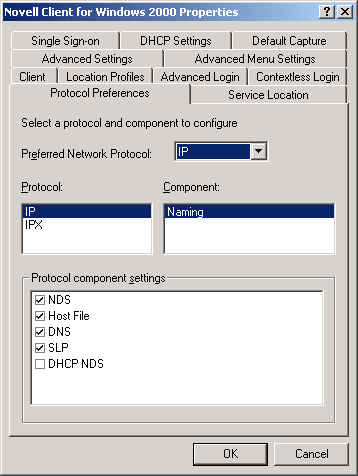Ensuring Successful Name Resolution for GroupWise Volumes
Because you are using cluster-enabled volumes for GroupWise domains and post offices, you must ensure that short name resolution is always successful. For example, in ConsoleOne, if you right-click a Domain object in the GroupWise View and then click Connect, ConsoleOne must be able to resolve the domain database location, as provided in the UNC Path field, to the network address of the current, physical location of that domain within your cluster. It is through short name resolution that all GroupWise cluster resources (such as domain and post office volumes) are accessed and managed in ConsoleOne.
A client program (such as ConsoleOne) that runs on a Windows* workstation, can be configured to use several different short name resolution methods. To see which methods are in use at a particular workstation, view the protocol preferences for the Novell ClientTM that is installed on the Windows workstation:

Short name resolution methods that pertain to clustering your GroupWise system are discussed below:
| Short Name Resolution Method |
Description |
|---|---|
eDirectory |
You can use eDirectory to resolve short names into specific network addresses. However, when using eDirectory for short name resolution, you must remember to consider current context in the name resolution process. eDirectory short name resolution works only if your current context is the same as the context of the eDirectory object you need to access. |
| Hosts Files | Windows uses the following files when performing short name resolution at the workstation: Using these files at the Windows workstation is not a preferred method for TCP/IP name resolution (except perhaps for the administrator's workstation). However, whenever you cluster-enable a volume, you should add its virtual server to the sys:\etc\hosts file of all nodes in the cluster. |
| DNS | Perhaps the most common short name resolution option is Domain Name Service (DNS). As with the HOSTS file, it is good practice to place all of your virtual servers into DNS. For short name resolution to work using DNS, the client workstation must either belong to the same DNS zone (such as support.novell.com) as the cluster resource, or the cluster resource zone must be configured in the client's DNS suffix search path under TCP/IP settings for the workstation. The underscore ( _ ) character is part of default cluster-related object names. Because it is not supported by the DNS RFC, some DNS name servers cannot resolve default cluster-related object names. If you are using such a DNS name server on NetWare 5.1, make sure you have installed the latest Novell Cluster Services snap-in to ConsoleOne, as described in Updating to the Latest ConsoleOne Snap-In, so that you can change cluster-related object names as needed to remove the underscore characters. |
| SLP | NetWare 6.x and NetWare 5.1 both use Service Location Protocol (SLP) to advertise service information across TCP/IP-based networks, which provides short name resolution of TCP/IP-based cluster resources within the network. On NetWare 6.x, Novell Cluster Services propagates virtual server information into SLP by default. On NetWare 5.1, Novell Cluster Services does not propagate virtual server information into SLP by default. If you want to propagate virtual server information to SLP on NetWare 5.1, you can run the (unsupported) CVSBIND utility, which gives you reliable short name resolution within your cluster regardless of shortcomings you might encounter with other name resolution methods. |
Specific setup instructions for each of these short name resolution methods will be provided in Setting Up a Domain and Post Office in a Novell Cluster.
| SYSTEM CLUSTERING WORKSHEET |
|---|
Under Item 9: IP Address Resolution Methods, mark which methods you want to implement in order to resolve the locations stored as UNC paths in ConsoleOne into physical network addresses in your system. |